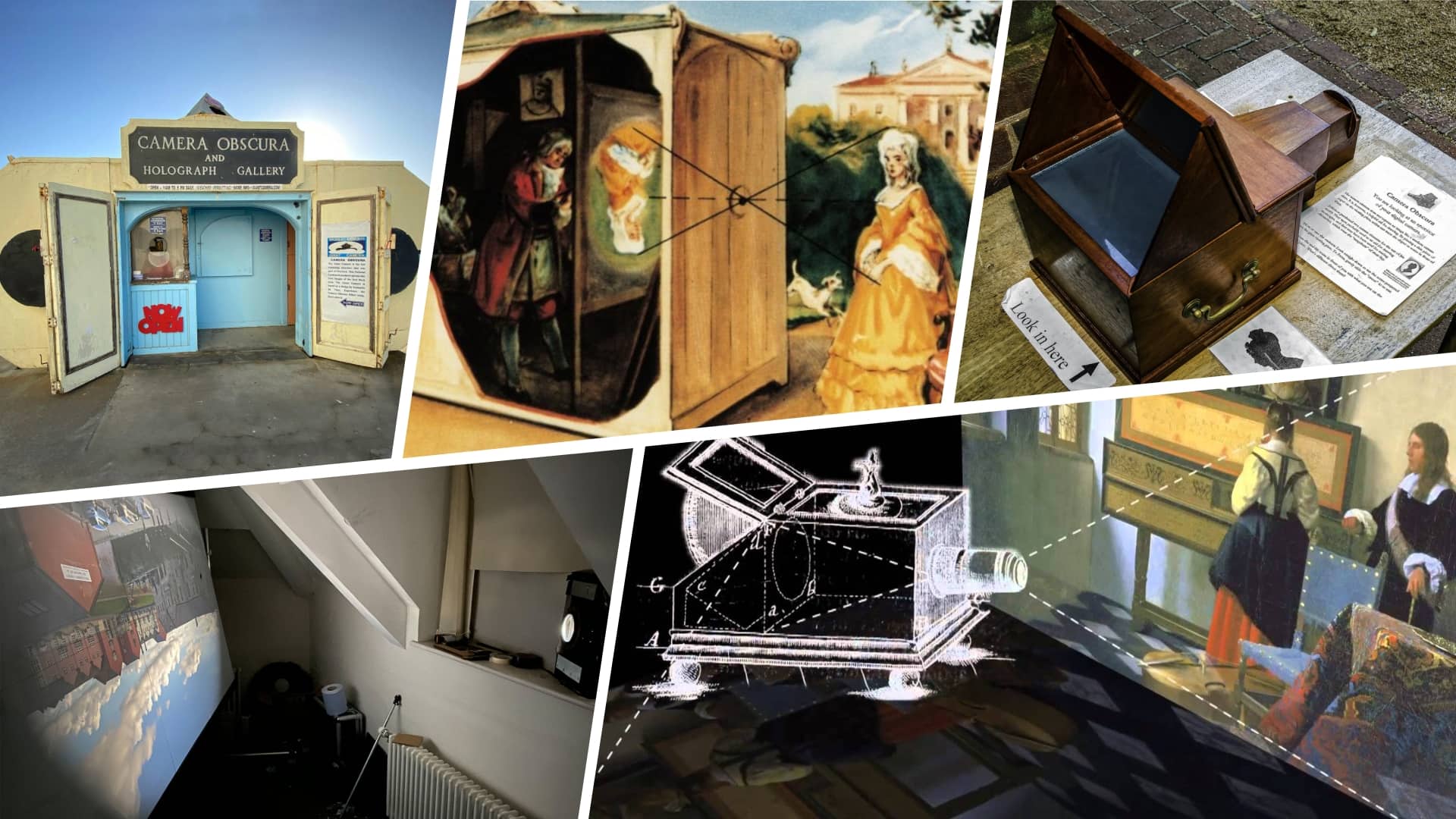What is a camera obscura? When was the camera obscura invented and who invented it? Many of us have heard the term… but what does camera obscura mean? We’re going to answer those questions by exploring their history, from prehistory to the modern day. We’re also going to show you how to create your very own “dark room” at home! By the end, you’ll know what a camera obscura is and why it’s so important.
Camera Obscura Origin
Early camera obscura history
Many anthropologists suggest that the camera obscura initially sprouted in the Paleolithic era. It may sound insane to think that hominins roughly three million years ago used camera technology – but it’s likely true.
During the Paleolithic era, hominins almost certainly used “keyholes” carved into caves, animal hides, or rudimentary walls, to project images.
Cave paintings from the time sometimes show signs of tracing consistent with the technique of tracing from a camera obscura. This field of study, known professionally as archaeo-optics, explores the camera obscura as the earliest form of art technology.
It’s clear that this phenomenon/device has a rich history. So without further ado, let’s define camera obscura.
CAMERA OBSCURA DEFINITION
What is a camera obscura?
A camera obscura is a room with a hole (or lens) in a wall that projects a reverse image onto the opposite wall. The idea of the Camera obscūra, which is derived from Latin for dark chamber or dark room, was conceived in prehistory, initially theorized around 500 BCE, and concretely developed in the Common Era.
This next video examines its history and the technology that makes it work.
The Camera Obscura by The Art of Photography
Camera Obscura Meaning
Development of the camera obscura
The camera obscura may have been used in the Paleolithic and Neolithic eras, but it wasn’t formally described until a few hundred years before the Common Era. Chinese philosopher Mozi is credited with first detailing the camera obscura; his writings on light reflection and image projection predated Aristotle’s musings in Problems by around 50-100 years.
Greek mathematician Euclid’s Optics (~300 BCE) proposed a theory called “geometry of vision” that sought to explain the mechanics behind light perception. Euclid’s writings, although not directly correlated to the camera obscura, explained how (and why) vision works.
Arab scientist Ibn al-Haytham explored the camera obscura in his Book of Optics (~1027), effectively explaining the mechanics behind an aperture.

Ibn al-Haytham’s Diagram
Italian polymath Leonardo da Vinci examined the phenomenon around 1502; writings later published in Codex Atlanticus. The diagram below shows how light projects at different angles, similarly to al-Haytham’s.

Leonardo da Vinci’s Diagram
Philosophers and scientists wrote about the camera obscura extensively (especially prior to the Renaissance) – but they didn’t build many surviving exhibits. Of course, these are simple machines.
As such, they’re rather easily disassembled. That said, there are a lot of famous modern examples. Let’s take a look at a few!
Where Can You Find One?
Modern camera obscura example
One of the most famous working examples in the world can be found at San Francisco’s Ocean Beach. This next video takes a look at the 1946 unit in further detail.
San Francisco Camera Obscura by Exploratorium
Many science museums/observatories around the world have some sort of camera obscura; The Griffith Observatory in Los Angeles, California included. Consider looking online for one in your area!
DIY Time
How to make a camera obscura
All of this talk about the camera obscura begs the question: is it a relic of the past? Well, it’s certainly true that current camera technology has made the them obsolete – but that doesn’t mean it’s not without merit.
The camera obscura explains a lot about camera technology and art; and building one is an exercise in understanding history.
This next video shows how you can make one at home. Follow the steps below!
How to Make a Camera Obscura by The George Eastman Museum
Here’s what you’re going to need (via The George Eastman Museum):
- Cardboard or black plastic sheeting
- Painters tape, and or electrical tape
- Scissors
- Pencil
- Card
- Washers
- Blade
Perhaps it goes without saying, but you’re also going to need sunlight and a room with a window.
- Remove any window furnishings
- Cut cardboard or plastic sheeting to a size that will completely cover the windows
- Use the painters tape or electrical tape to tape the cardboard or plastic sheeting around the windows
- Trace the washer with the pencil on the card, then cut out an aperture with the blade. “The smaller the hole, the sharper the image.”
- Cut a small hole out of the cardboard or plastic sheeting with the blade
- Use the painters tape or electrical tape to tape the card with the aperture to the carved out space
- Shut off (or remove) all additional light sources
- If possible, hang up a white sheet on the wall opposite the aperture
The process of making a camera obscura is a great challenge for anybody, from science class students to learners at home.
Up Next
When Was the Camera Invented?
We answered the question “when was the camera obscura invented,” but when was the camera invented? Was the camera obscura the first camera? The jury’s still out on whether the camera obscura was the first camera – some say it is, others say it isn’t. Follow along as we explore the history of photography, from camera obscuras to Niépce and Daguerre. By the end, you’ll know when photography was invented, and why some consider the camera obscura to be the first camera.
Up Next: History of Photography →
Share your vision with elegant shot lists and storyboards.
Create robust and customizable shot lists. Upload images to make storyboards and slideshows.
